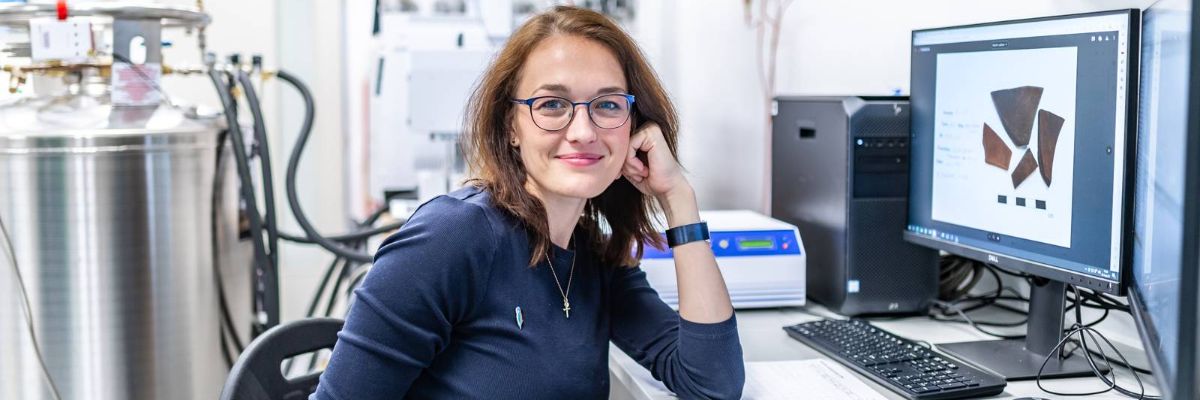
“Fat can be extracted even from thousand-year-old pottery,” says V. Brychová
26. 04. 2024
Jokingly dubbed “the expert on greasy dishes” by her relatives, Veronika Brychová finds herself peering into the culinary habits of ancient peoples through shards of prehistoric pottery, using fat residues to uncover what our ancestors cooked – and when. In the evenings, she swaps out particle accelerators for LEGO and fairy tales – or the church organ. The interview (below) with the young scientist from the Nuclear Physics Institute of the CAS was featured in the quarterly A / Magazine of the Czech Academy of Sciences.
*
To oversimplify, you basically spend your time at work peeking under the potlid of prehistoric people’s lives. Do you reckon we’d enjoy their cuisine?
I’d say so, yes. Although we’d understandably have no luck finding things like my favorite schnitzel or Moravian [double-filling] kolaches that we know from our grandmothers’ recipes in their repertoire. However, they regularly roasted meat, seasoning it with salt and other ingredients. Personally, I wouldn’t turn down a meal like that!
So, we’re all set with a substitute for schnitzel. But what about dessert? Would they have treated us to something sweet?
Perhaps. Already in the Neolithic period, people were grinding flour and using natural sweeteners like honey, wild berries, and apples, so they could have prepared something like pastries. They were probably much crunchier than modern-day equivalents, though not exactly in a desirable way.
What do you mean?
Back then, they ground flour using stones, shards of which would end up in the produced flour. Dental findings prove this, displaying significant wear on the enamel of the examined teeth. The transition to a more settled way of life that occurred in the Neolithic took quite a toll on dental health overall. With the shift from the hunter-gatherer to an agricultural lifestyle came an increase in carbohydrates in the diet that came from cultivated grains, leading to a significant increase in cavities.
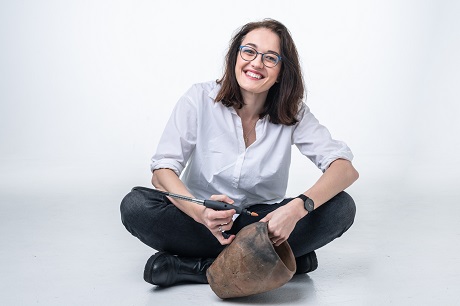
But in the diet of that time, you’re mainly interested in fats…
Yes. Unlike carbohydrates or proteins, fats can be extracted from pottery that is thousands of years old. Mainly because fats are lipophilic, meaning they dislike water. Pottery, on the other hand, is porous and acts like a sponge. So, fat tends to happily seep into these pores, to occupy all the nooks and crannies, and stay put.
It makes itself at home in the receptacle.
Exactly. The more often fat-rich food was cooked in it, the more fats then ‘stuck’ in the pottery. However, fat can also penetrate the porous wall of ceramics when it’s cold, too. Either way, the living conditions are satisfactory, so it doesn’t matter if the container was used last week or three thousand years ago. During analysis you’ll always find the fat, even if the artifact has been buried underground for years. Typically, soil microorganisms don’t expel fats out of the pottery either – they are orders of magnitude larger, so they cannot penetrate the small holes to metabolize the lipids.
Are proteins and carbohydrates not so resilient?
Unfortunately not. Compared to fats, they are much more polar [and hydrophilic], so water can flush them out. Also, being larger, the geometric form of their molecules doesn’t allow them to adhere as well to the porous walls. That’s why they are much more susceptible to microbial degradation than fats. Simply put, you usually won’t come across proteins or carbohydrates in archaeological pottery.
Thankfully, at least grease reigns eternal! What insights can you glean from the fats you find?
By analyzing organic residue, I can determine which types of lipids and lipophilic substances I’m dealing with. I can then discern what was being prepared in the examined vessel. Most commonly, I come across animal fats from pork lard, beef suet, and milk, but plant-based fats are not uncommon either. By identifying these substances, I contribute my bit to what’s called paleodietary reconstruction, i.e., refining our understanding of what our ancestors ate.
A well-rounded contribution indeed...
And it’s not insignificant. Most people associate fats with meat, but you can find them in all sorts of things. For instance, brassica plants have a high erucic acid content. If I detect this fatty acid in the pottery, it suggests that it was likely used to cook cabbage or another plant from the Brassicaceae family. I simply look for various lipophilic biomarkers contained in the shards; organic substances representing specific natural sources – such as resins or tars from trees, beeswax, or certain plant species. Moreover, I can often deduce from their degradation products what was going on with the vessel.
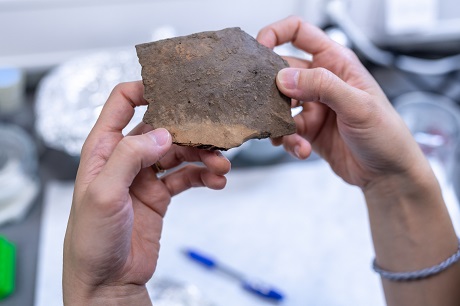
During the cooking process, most of the fat would end up embedded in the ceramic wall below the brim of the pot.
What does it tell you about it?
For instance, when I come across markers of high heat, it’s clear the vessel wasn’t used for food storage alone, but also for cooking. And if I find traces of resins, I can even identify the type of wood they used for fueling the fire that heated the food.
So, from a tiny fragment, you can deduce that it was, let’s say, beef broth simmering in the pot over a pine-log fire, thousands of years ago?
Basically, yes. I might not be able to extract all the ingredients of that prehistoric recipe out of a potsherd [fragment], but the lipids and lipophilic substances reveal quite a bit. By analyzing them, I can assemble the puzzle pieces and, using chemistry, essentially chart the life story of the artifact. Each fragment is unique, and I never know beforehand what I’ll discover in it. It’s a kind of detective work, and there’s always suspense in anticipating the outcome.
Must be exciting for the archaeologists who brought you the fragment in question, too!
For sure. Often, they want its age to be determined as well. But it’s not always possible. Pottery can be dated only if the container was used for preparing fat-rich food and if I manage to isolate enough fatty acids from the sample needed for radiocarbon dating – which isn’t revealed until the initial screening.
So even determining the age of the pottery finds wouldn’t be possible without the fat?
Exactly. It wouldn’t work without fats. Or to be more precise – without carbon, which fats, like all organic substances in the world, are composed of. The natural composition of this element consists of three isotopes: stable 12C and 13C, and radioactive 14C, which occurs in trace amounts and constantly decays back into nitrogen. It’s this last isotope, radiocarbon, which is crucial for dating. Because we know its half-life, we are able to calculate the age of organic material in which radiocarbon is found – whether it’s pottery, bone, or a piece of wood.
Phew... Could you simplify this a bit more?
I can try. Radiocarbon is formed by cosmic radiation in the upper layers of the atmosphere. It then enters the natural carbon cycle in the form of carbon dioxide and ends up in plants and animals, including humans. Meanwhile, the radioactive isotope of carbon inside these organisms continuously decays into nitrogen. However, all organisms continually replenish their radiocarbon from their surroundings, so its concentration within them remains in balance. If this intake is interrupted, the organism is excluded from this cycle, and 14C no longer replenishes, it only decays. By measuring the residual concentration of radiocarbon in the organism, we can thus determine when this exclusion occurred.
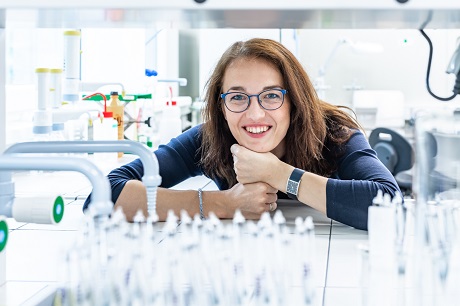
As in, when the organism died?
Not necessarily. For instance, when human remains are dated using radiocarbon dating, you get several different temporal readings. Fats, hair, and nails renew quickly. Therefore, the time of cessation of their radiocarbon intake roughly coincides with the individual’s time of death. Teeth, on the other hand, finish forming at about twelve years old and no longer exchange carbon with the environment afterwards. So, if you date teeth this way, you can estimate when their owner was born. With bones, it’s another story.
And what about when you’re analyzing pottery?
If it was used to cook meat, and the fat seeped into the vessel’s porous walls, we can actually measure when the animal died. And since we assume people cooked meals using fresh meat, the date corresponds to the cooking period as well. However, the older the samples, the more challenging their dating becomes due to the decreasing amount of radiocarbon. After about fifty-five thousand years, we aren’t able to find any radiocarbon in the artifacts at all – most of it has decayed into nitrogen by that point, and even modern sensitive instruments can’t detect it. Fortunately, this doesn’t pertain to pottery, as it only began to be produced on a larger scale during the Neolithic.
How large a potsherd do you need to be able to extract its story?
The ideal size is five by five centimeters, but I can make do with much smaller pieces, too. For organic residue analysis, I need two to three grams of a sample. If I want to date the material as well, I need a bit more. However, we’re still talking about mere grams.
Does it matter which part of the receptacle it comes from?
It matters a bit. It depends on the type of vessel, but from simulation experiments, we know that in pottery used for cooking, the concentration of lipidic substances decreases from the brim towards the bottom. And since grease floats on the surface, during cooking, most of the fat would transfer to the ceramic wall just below the brim of the vessel.
So, those fragments have the highest nutritional value?
Most of the time, yes. But if the vessel was used to store cooked meat (covered with lard to preserve it longer), I’d find plenty of fat throughout its profile. However, if it was something like a water jug or a bowl for storing something fat-free, then I’m out of luck. Even so, the hours spent analyzing the sample aren’t wasted because we can at least confirm the original function of the vessel.
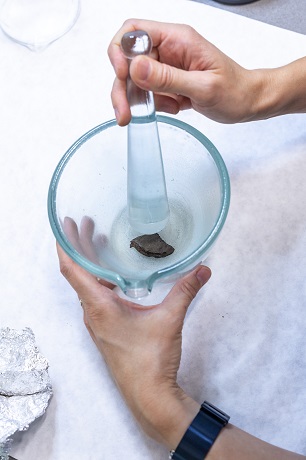
It’s necessary to break the cleaned fragment into pieces and then ground it into a powder.
Hours? What sorts of things do you do with the fragment to figure out its secrets?
First, I have to thoroughly clean each sample to remove any secondary contamination. Otherwise, it would retain traces of substances that could compromise the measurement results. For example, plasticizers found in plastic bags that archaeologists often use to store artifacts can migrate from them to the samples. All this “dirt” has to go. So I first use an angle grinder. Then I break off a piece from the properly cleaned potsherd and grind it into a fine powder. I add extraction solvent to it and further prepare the sample in order to insert it into Leczo.
I take it you’re not referring to the Hungarian dish, are you?
Yeah, no. That’s the nickname my colleagues and I use for the instrument that analyzes what the sample contains using gas chromatography and mass spectrometry methods. Part of the device is supplied by the Leco company, and their Hungarian technician always pronounced the company’s name as “Leczo.” And since we’re fond of nicknames in our lab, it caught on right away. (laughter)
Do the other instruments have nicknames too?
Not all of them, but most of my colleagues call our newest particle accelerator, officially named MILEA, Miluška. Even though it’s about fifteen by five meters and an entire new hall had to be built to house it. It’s this device that helps me with radiocarbon dating.
So, when you need to determine the age of a potsherd, you run it through Miluška?
It’s not that simple. Even in this case, I have to start with cleaning, grinding, milling, followed by Leczo. Then, I have to play around with the carbon – because each potsherd contains different sources of this element. Carbon could’ve embedded itself in the pottery artifact through human touch, from the soil, its walls could’ve absorbed fats at different times… If I want to find out when the vessel was last used for cooking, I have to focus on carbonaceous substances that represent this activity.
What exactly are you looking for, then?
In ceramic vessels used for preparing fat-rich food, the largest proportion comprises usually two fatty acids – palmitic and stearic acid. That’s why I’m on the hunt for their molecules. Once I manage to isolate them, I try to obtain a carbon form that can be dated from the sample. This carbon form then needs to be burned into CO2 – by placing it in quartz ampules overnight into the furnace where it’s heated to nine hundred degrees.
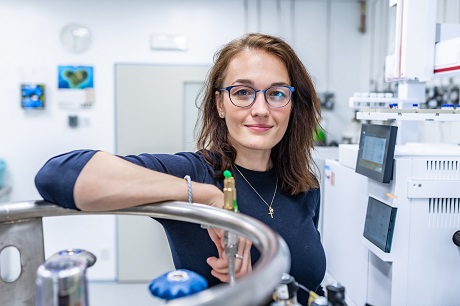
And then it’s fresh out of the oven in the morning!
Almost, but not quite. The produced carbon dioxide still needs to be reduced to graphite. That then goes into the accelerator, which counts the individual atoms of radiocarbon preserved in the sample. So, the journey from receiving the potsherd to Miluška spans several days. And even then it’s not over.
Miluška doesn’t just churn out the dating for you?
No. The calculation needs to be compared with what we call the archaeological standard and then calibrated. That means taking into account where the examined potsherd comes from. Each part of the planet has different flows of carbon dioxide – there’s a difference between a sample from Oceania and one from Europe. Each region has its own special calibration curve that helps refine the dating.
And after all this, can you finally announce to the archaeologists that the ceramic vessel in question had been used for cooking in, say, 2,354 BCE?
I can’t determine it that precisely. I can only establish a time range in which it might’ve happened. The timespan depends on how much the production of CO2 fluctuated at that time. When everything goes well, I can determine a timespan of about a hundred years in which cooking might’ve occurred, for instance, during the Linear Pottery culture. Which, considering the artifacts are roughly eight thousand years old, can be considered a success.
Do you date the age of other types of artifacts, too?
Yes. Although I mainly deal with pottery, our lab routinely dates the age range of bones, various wooden artifacts, charcoal, grains... But it’s not just archaeologists who approach us; we also assist criminal investigators.
Do you help them out with investigations?
We analyze forensic samples, such as ivory, keratin, dentin, and even animal hair. So for instance, customs officers might confiscate an ivory figurine, and inspectors bring it to us for dating. If we find out it comes from an elephant tusk hunted illegally, that is, after 1947, we can provide them with evidence for criminal proceedings.
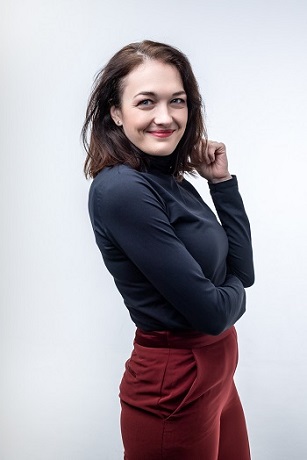
So you’re not just uncovering history, but crimes as well.
To some degree. Unlike archaeological material, we can date these relatively recent forensic samples fairly accurately. And though it might sound strange, we owe this to nuclear weapons tests conducted in the 1950s and 1960s.
Why is that?
After the 1620s until roughly World War II, the production of carbon dioxide in the northern hemisphere was fluctuating. So, when archaeologists send us, for example, a bone for radiocarbon dating that they believe is from the 18th century, our measurements usually yield several equally probable intervals between 1650 and 1940. Unfortunately, due to the fluctuating atmospheric CO2 production curve, we can’t narrow it down to the exact age of that bone.
But how does this relate to nuclear weapons?
It was their testing that changed this trend. Due to nuclear tests, the concentration of radiocarbon in the atmosphere roughly doubled. It peaked in 1963 when the memorandum to halt nuclear weapons testing was signed. This fluctuation is called the bomb spike, and thanks to it, we can now date forensic samples from the second half of the 20th century with precision down to a few years.
At least the nuclear tests brought something positive...
That’s one way of putting it. However, due to our fossil CO2 production and other influences, the concentration of carbon dioxide from the bomb pulse diluted to pre-bomb-testing levels by 2021. Soon, then, the possibility of such precise dating will be gone.
Let’s go back to pottery. You’re the only one in the Czech Republic who can decipher what was cooked in ancient ceramic pots and when. How did you learn to do that?
I originally studied food chemistry and technology at the University of Chemistry and Technology in Prague. It was during my PhD studies that I by chance got involved in work with archaeological ceramics with preserved food residues. But nobody had really thought to analyze them, and because I’ve always been fascinated by history, the prospect got me excited. However, nobody in the Czech Republic was doing anything similar at that time, and I didn’t know where to start. Fortunately, I got in touch with the University of Bristol, where they introduced me to the methodology. So, I transitioned from studying contemporary foods to prehistoric ones, and history found me after all.
Was this something you dreamed of doing as a child?
Not exactly. Growing up, I wanted to be a paleontologist. I was interested in prehistory, I devoured books by Eduard Štorch and loved Zdeněk Burian’s drawings of dinosaurs and mammoths. But I also adored the Horrible Science book series, and I would conduct all sorts of experiments at home. I remember filling the yellow plastic capsule from a Kinder Surprise Egg with vinegar and baking soda with my friend and waiting to see if it would explode!
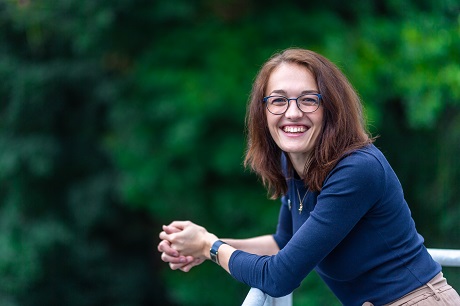
So you were obviously drawn to history and science from an early age.
I’d say so. Later, I became quite interested in chemistry and math. But also a million other things. I grew up in a small village on the border of southern Bohemia, Moravia, Vysočina, and Austria, and I’d spend most of my free time with friends in the forest. Back then, I wouldn’t have ever even dreamed of one day working at the Nuclear Physics Institute.
Does your family understand what you do?
They know that I try to figure out what people ate in the past by examining the fat residues in potsherds. Some relatives jokingly call me the “expert on greasy dishes.” (laughter) My mom is an office worker, my dad a machinist, and my husband an economist. I don’t talk to them much about residual analysis, but they have some idea and are always interested in how my work is coming along. However, it doesn’t matter much to my three- and five-year-old sons yet. They have other worries – like me not ruining their T-Rex and dragon carnival costumes.
So besides ceramics, you also work on masks now?
Not anymore, thank goodness. But making all those claws and teeth so the boys would approve of them was quite a feat. Combining motherhood with science is in general quite a challenge. I wouldn’t trade it, though. It wouldn’t have been possible at all, however, especially in the beginning, without the help of my family and the supportive approach of my supervisors.
How quickly can you switch from Leczo to Lego in your thoughts?
Sometimes it’s necessary to do it from one second to the next, but I guess every working mom can relate to that. Recently, for example, I was solving issues with Leczo over the phone with a coworker while holding my younger son and building towers with blocks with the older one. Sometimes it’s a juggling act, but at home, I try to be primarily a mom. Usually, I can become a scientist only after the boys fall asleep.
Only after a bedtime story...
But sometimes there are as many as twenty of them. By the time I’m done reading to the kids, I’m exhausted, and science has to wait. (laughter) Thank goodness my husband and I take turns putting the boys to bed.
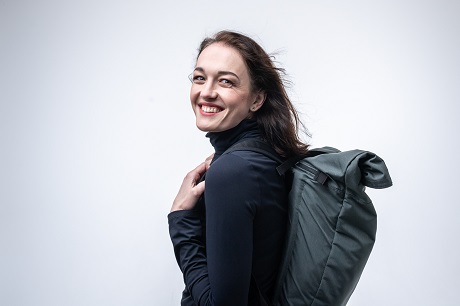
You’re exploring the cuisine of our ancestors. Do you yourself like to cook?
Sure. Sometimes it feels more like a routine for me, but I enjoy trying out new recipes. Occasionally, though, I’d rather make myself a cup of tea and curl up with a book in an armchair. However, at the moment, this scenario mainly falls into the realm of science fiction due to a backlog of work.
So how do you relax?
I’ve learned to relax even while cleaning. It calms me down and clears my head. I also unwind while cycling or during hikes in nature. Or when I sit down to play the piano or organ.
You can play the organ?!
A little. I’m more of an amateur organist. When I was in high school, the church in our neighboring village needed an organist. Since I played the piano, they asked me if I’d like to play the organ during mass. That’s how I started learning it. My grandfather was an organist at the Church of the Most Sacred Heart of Our Lord on Jiřího z Poděbrad Square in Prague for many years. When I moved to Prague for university, he would tutor me on the organ after mass.
Sounds like playing the organ runs in the family.
Perhaps. Our family is overall pretty musical. Everyone at our house either sang or played some instrument. We could easily start a band! For instance, my dad can play the clarinet, saxophone, and drums. He met my mom in the church choir. You know where?
Let me guess – the Church of the Most Sacred Heart of Our Lord?
Bingo! The destinies of our family somehow intertwine in this Plečnik church. My grandpa played the organ there for forty years, my parents met and got married there, as did I. To this day, I occasionally stand in there as an organist. By the way, I also met my husband in a choir, but at university. He’s a baritone, and I’m an alto. My father-in-law led that choir, and my mother-in-law sang in it. And it’s there that they also met, years ago.
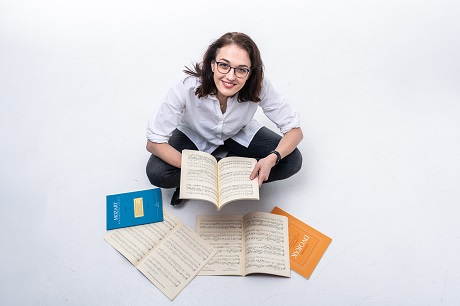
Looks like the choir works as an effective matchmaking service.
I think so, too. Singing really does connect people. Unfortunately, with two kids and work, we don’t have time to attend rehearsals anymore, so we occasionally sing at home. My husband might start humming something, and I jokingly ruin it with a second voice. After a while, the kids start yelling at me: “Mom, please, stop singing!”
The boys don’t like music?
They do, but only some of it. Whenever I play the piano at home, they immediately want to join in. They climb onto my lap and enthusiastically demand their favorite songs. So my repertoire has recently narrowed down to the theme song from Bob and Bobek, Rain, Rain, Go Away, and other kid tunes.
And at work? Do you do a lot of humming there?
Oh, absolutely! I sing quite a lot – folk songs, classics, whatever, really. When things in the lab aren’t going well, I might sing something like “Naše Káča pláče, co je jí?” [“Why is Our Katy crying?”] And if things go well, something like Handel’s “Hallelujah” chorus pops into my head. But sometimes there’s just no time for music. Sometimes I feel like my day is divided into minutes, and I'm in a whirlwind. I even speak quickly, and I practically sprinted down the wedding aisle, too. I'm always on the go. My grandpa was also like that. If he ever happened to sit down somewhere, everyone thought he was sick. I guess I take after him in this respect, except my grandpa always looked cheerful and content no matter what. Well, there’s always something to catch up on! (laughter)
*
Ing. Veronika Brychová, Ph.D.
Nuclear Physics Institute of the CAS
Veronika Brychová studied Food Technology at the University of Chemistry and Technology in Prague, where she also obtained her PhD. She gained experience at universities in the UK and Switzerland as well. Since 2017, she has been working at the Nuclear Physics Institute of the CAS, specifically in the Department of Radiation Dosimetry and the Czech Radiocarbon Laboratory. Her research focuses primarily on molecular-specific radiocarbon dating of archaeological material and its organic residue analysis. In 2023, she received the Otto Wichterle Award for outstanding young scientists.
*
The interview first appeared (in Czech) in the A / Magazine quarterly published by the Czech Academy of Sciences:
Prepared by: Radka Římanová, External Relations Division, CAO of the CAS
Translated by: Tereza Novická, External Relations Division, CAO of the CAS
Photo: Jana Plavec, External Relations Division, CAO of the CAS
 The text and photos are released for use under the Creative Commons license.
The text and photos are released for use under the Creative Commons license.
Read also
- A trapped state: The pandemic impact on public attitudes, trust, and behavior
- Aerial archaeology: Tracing the footsteps of our ancestors from the sky
- Archaeologists uncover ancient finds along Prague Ring Road
- Our microbiome largely depends on what we eat, says microbiologist Michal Kraus
- The ABCs of writing: Why did its invention mark a turning point for humankind?
- We learn, remember, forget… What can memory actually do? And can we outsmart it?
- New Center for Electron Microscopy in Brno opens its doors to global science
- The hidden lives of waste: What can we learn from waste workers and pickers?
- A unique lab is hidden right beneath Prague’s Vítkov Hill
- Renewables are a strategic investment in European security, scientists say
The Czech Academy of Sciences (the CAS)
The mission of the CAS
The primary mission of the CAS is to conduct research in a broad spectrum of natural, technical and social sciences as well as humanities. This research aims to advance progress of scientific knowledge at the international level, considering, however, the specific needs of the Czech society and the national culture.
President of the CAS
Prof. Eva Zažímalová has started her second term of office in May 2021. She is a respected scientist, and a Professor of Plant Anatomy and Physiology.
She is also a part of GCSA of the EU.